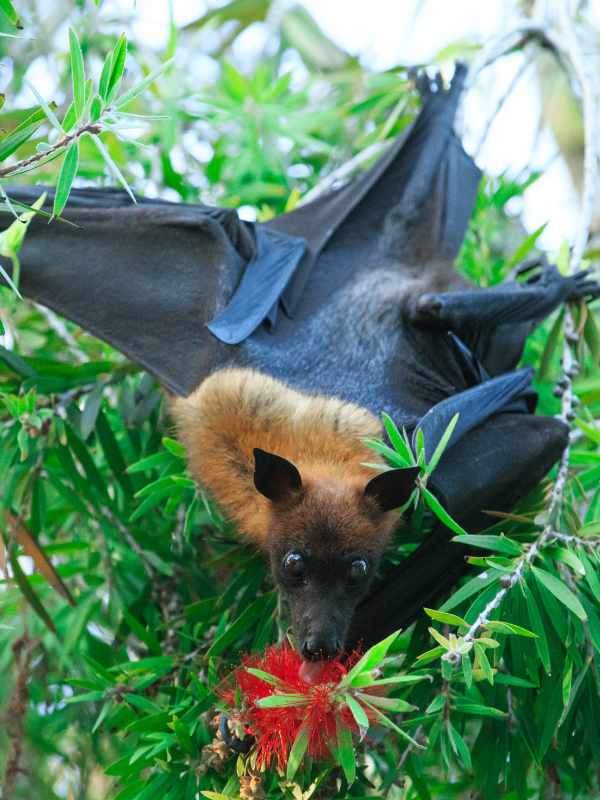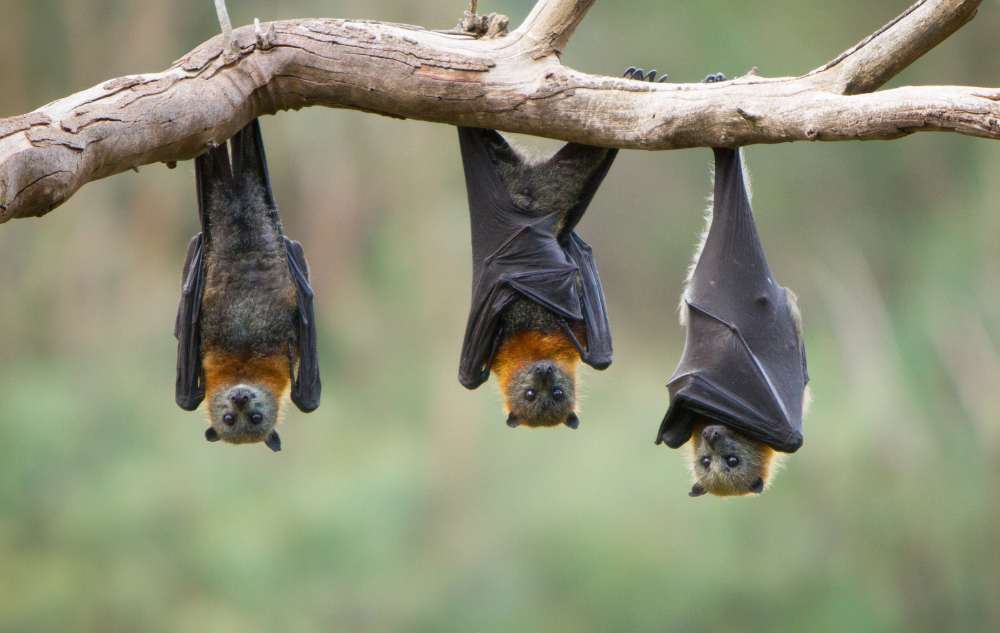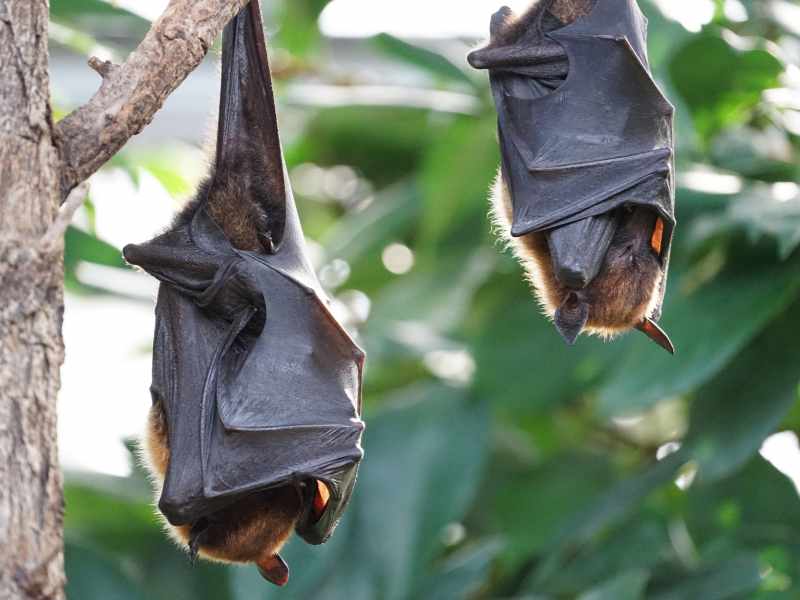Celebrate the rockstars of Halloween and learn about the wonderful world of bats!
Bat Week, which runs from October 24-31, is a global celebration of the spooky creatures that are crucial to our ecosystems. Let’s dive into the mysteries of these nocturnal wonders!
Bat Cribs
You can find these small, secretive creatures in secluded shelters like caves, tunnels, bridges, mines, vacant buildings, and even your attic. Bats are like nature’s detectives. Their longevity and sensitivity to environmental changes make them reliable indicators for monitoring the health of local organisms and ecosystems.
Fly, My Pretties, Fly!
Bats are the only mammals that can truly fly. They are aerodynamic multitaskers that like to eat on the go! From March through September, bats chow down on moths, beetles, gnats, pesky mosquitos, and crickets. Imagine having a late-night snack that is 50% of your body weight!
Mother Nature’s Helpers
Bats are pollinators and seed spreaders. As they scatter seeds, they aid in regenerating forests, native wildflower areas, fruit crops, and your garden. They pollinate over 500 different types of tropical plants each year.
Move over, chemical fertilizers! Bat poop (also known as guano) is rich in nitrogen, phosphate, and potassium – a fertilizing powerhouse that helps plants grow big and strong. According to The Nature Conservancy, “Guano was Texas’s largest mineral export before oil!”
Medical Marvels
Bats have been used in medical research to help study longevity and metabolism. This research has also advanced knowledge in drug research, blood circulation, stroke treatments, and the development of devices to assist people with visual disabilities.

Incredi-bat-ly Diverse
Bats are the second most diverse order of mammals, with about 1,200 to 1,400 species worldwide. According to the North American Bat Monitoring Program (NAbat), eight species or subspecies in the U.S. are listed as endangered by the federal government.
Bat Myths Unraveled
It is a common misconception that all bats carry rabies. In the United States, less than a fraction of a percent have the disease, so there is little danger to humans. Bats, despite their appearances, are clean animals. Like cats, they groom, lick, and scratch themselves for hours.
Is the Eastern European tale of a vampire bat a myth?
The story dates back to the Middle Ages, and is about a man (surely not Bela Lugosi) who died and came back to life and sucked the blood from the neck of humans. The Vampire Bat is named more for the legend. They feed on the blood of cattle, horses, and wild animals such as deer. This species rarely bites humans.

Bat-natomy
- Bats’ eyes might be small, but they are not all blind. They are color-blind and can see three times better than humans.
- Bats’ ears are large, mobile, well-developed, and extremely sensitive to sound. In fact, they use an acoustic orientation called echolocation, which works like an auditory GPS. They emit high-frequency sound pulses through their mouth and nostrils to catch prey in total darkness. By listening to the returning echoes, they can discern their prey’s size, shape, texture, distance, speed, direction, and movement.
- A bat’s echolocation is so sensitive that they can detect objects as thin as human hair in total darkness. Fascinating! Scientists who study echolocation consider these creatures valuable for learning about their environment and biological habits.
- The thin-skinned membrane structure of their heavy-boned and muscular wings is similar to that of human arms and hands.
Just Hangin’ Around
Hanging upside down is a bat’s favorite pose, making it easy for them to take off quickly when danger approaches. During daylight hours, bats will roost in pairs. They wrap themselves with their wings like a cloak and hang upside down using their feet. Hanging upside down make hunting or escaping from predators quick and easy – they can evade owls, hawks, or snakes by simply letting go of whatever they are hanging onto, dropping, and taking off. Their inverted, relaxed position also exerts less energy. They use their talons to effortlessly grip in a deserted dark and safe location to rest.
Humans can’t hang upside down for an extended time. When inverted, a human’s blood pressure increases and our heartbeat slows down, which can lead to blood clots, blindness, and death. But bats don’t have that problem! According to Bat Conservation International, “Bats’ small and compact body allows its circulatory system to efficiently distribute the small blood volume in the valves in its veins and arteries to keep blood flowing in the right direction when hanging upside down.”
Parenthood is Batty
Most bat species mate in the late summer or early fall. In early June, females will birth one pup annually. The pup can weigh up to one-third of her mother’s weight. Mom will nurse and carry her young in a pouch in the days following birth. As the pup gets a little older, it will be left behind, clinging to the wall or roof of a cave or other shelter, waiting for mom to return with food.
Mortality for young bats is very high. They are prone to falls, parasites, malnutrition, disease, and unsuitable places to roost. Bats experience stress like humans do, but stress for these creatures can lead to death. Properly placed nursery boxes near abundant insect populations help ensure lower stress and lower newborn mortality.
Older bats can live up to 20 to 30 years. The most senior living bat was a male Brant’s Myotis that lived to be 41 years of age.
A Fungus Among Us
The Little Brown, Indiana, and Northern long-eared bats in North America have dramatically diminished in population due to white-nose syndrome, a white fungal disease contracted from physical contact with unhealthy bats.
The white-nose fungus primarily infects the skin of the muzzle, ears, and wings during hibernation, causing bats to wake up to daytime activity at warm temperatures. This results in weight loss because they are using their fat reserves before intended. Over time, they become dehydrated and ultimately starve to death before spring.
When a bat population is eliminated, so much of our ecosystem is affected. Insect populations increase, which impacts our environment, forest, and agriculture, as well as increased amounts of money on the annual elimination of pests. According to Whitenosesyndrome.org, “Bats contribute about $3.7 billion worth of insect control for farmers in the U.S. each year.”
How can you lend a hand to the bat community?
- Learn more about these unique mammals through your community, state, and national parks.
- Participate in a citizen science or stewardship program with your local park educator. You can help build a shelter for bats, such as a box, house, or condo. This style of housing is preferred by brown, endangered Indiana, and northern long-eared bats.
If you are an adventurous individual who likes to explore caves, please make sure you clean and disinfect your shoes, clothing, and gear after any cave trek. It helps eliminate the spread of white-nose fungus syndrome.
Let’s give bats the applause they deserve! Without them, our world would be a lot less batty and a little more buggy.
Discover more about our natural world with these One Planet Life blogs:

Written by Yvonne Dwyer
Master Naturalist and OPL Content Contributor
“It is truly an honor for me to be a contributor to One Planet Life. By sharing my experiences and lifetime of learning, I hope to inspire conservation, sustainability, stewardship, and awareness of enjoying the natural wonders of the world for the wellbeing of people and the planet.”












